Automated software deployment is the auto-distribution of all packages in a working environment without zero to minimal manual intervention. Distributing software to all machines in a network can be a daunting task for IT Administrators, especially at large enterprises. With an ever-growing number of endpoints, it is becoming a real challenge to roll out software across organizations. Endpoint Central allows you to distribute software packages and automate software deployment and mobile app distribution in all the computers across your network across Windows, Mac, Linux, iOS, Android, tvOS, chromeOS from a central console using an automated deployment tool and without any user intervention.
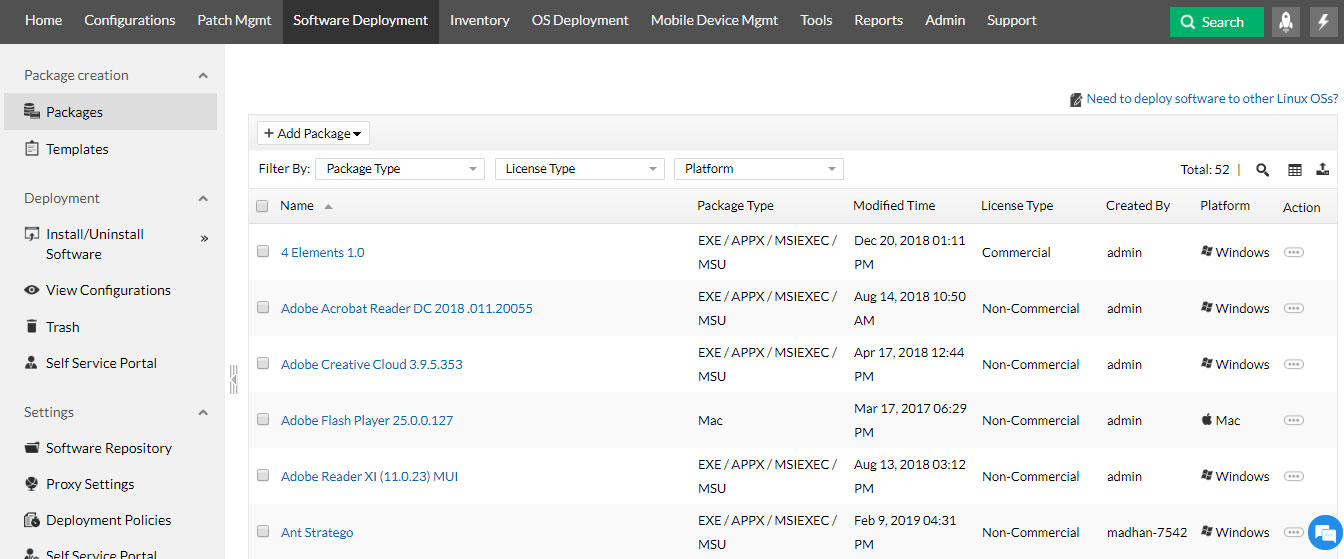
Enterprise software deployment automation tools ensure that the distribution of all packages in a working environment are automated. The application comes with a feature-set that has the following advanced options to offer greater flexibility and control over the automated deployment process:
Pre-defined application templates
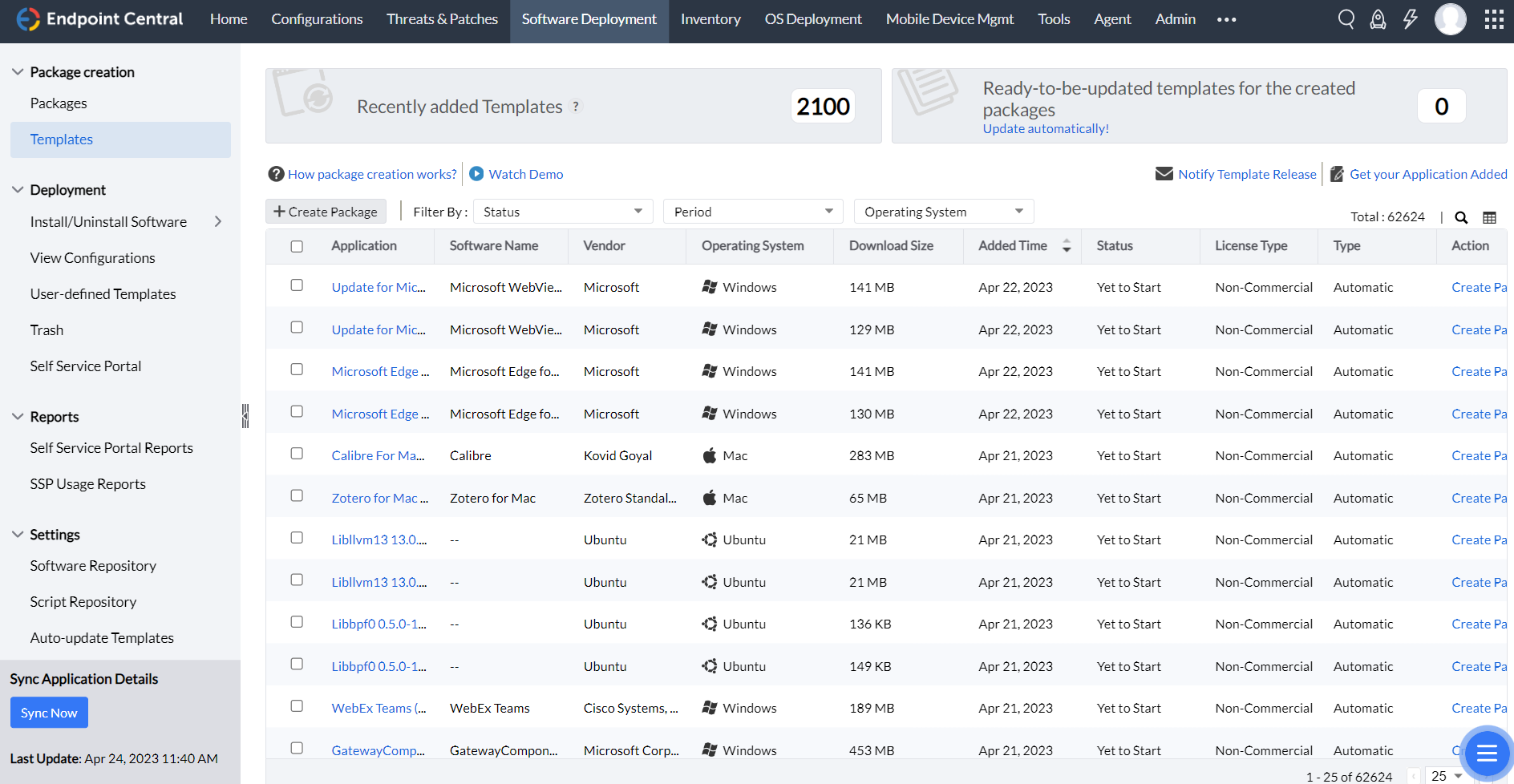
For deploying applications, you first need to create software packages, which can get tedious. Our automated software installation tool has over 10,000+ pre defined application templates, complete with install/uninstall switches which can be used to create packages instantly. This saves time, makes the software installation process faster, moreaccurate, and eventually helps in automated software deployment.
Software repository
All the software packages which are created using our automated software deployment tool are stored in a central Software Repository. Once saved, these packages can be reused multiple times for your enterprise software deployment process. There are two types of software repositories available: Network Share Repository and HTTP Repository. Network Share repository is used while deploying software packages to LAN agents and HTTP repository is required for deploying software packages to WAN agents.
Mobile app distribution
You can deploy all the apps you need in bulk to users or devices with one click, whether they are custom-built or available on the app store. Manage all aspects of app management - installation, deletion, update, and license management. Integrate with official app stores for OSs to distribute apps. Deploy in-house apps in various formats: IPA, APK, XAP, MSIX, APPX, APPXBUNDLE, and MSI.
Software metering
Software metering is a powerful tool that empowers IT administrators to optimize software license management and reduce IT expenses. It goes beyond simply tracking software installations; it analyzes actual software usage to identify opportunities for cost savings.
Many organizations unknowingly pay for licenses for software that is rarely or never used. This can be due to factors like:
- Unused pre-installed software that comes with devices.
- Deployment of software for specific projects that are no longer active.
- Employees installing unauthorized software.
These unused licenses translate to wasted IT budget. Software metering tools track and analyze software usage data across your network. This data typically includes:
- Installation details
When and where software was installed.
- Launch frequency
How often a program is opened.
- Active usage duration
The amount of time users spend actively using the software.
Benefits of software metering
- Identify underutilized software
Metering reveals software with low usage, allowing you to target it for removal or license renegotiation.
- Optimize license compliance
Ensure you have the correct number of licenses for the software actively used, avoiding potential compliance issues.
- Informed purchasing decisions
Data-driven insights help you make better decisions about future software purchases and subscriptions.
- Improved software deployment
Metering helps prioritize software deployments based on actual user needs.
Software metering tools typically provide three key reports:
- Software metering rules summary
This report details software usage based on pre-defined metering rules. It shows the number of installations, active users, and usage duration for each metered application.
- Computers with metered software
This report dives deeper, providing usage details (usage count and duration) for each software application on every computer. This helps identify underutilized software on specific devices.
- Users with metered software
This report focuses on user-specific software usage across all the devices they log into. This is valuable for managing licenses for software assigned to specific users.
Self Service Portal
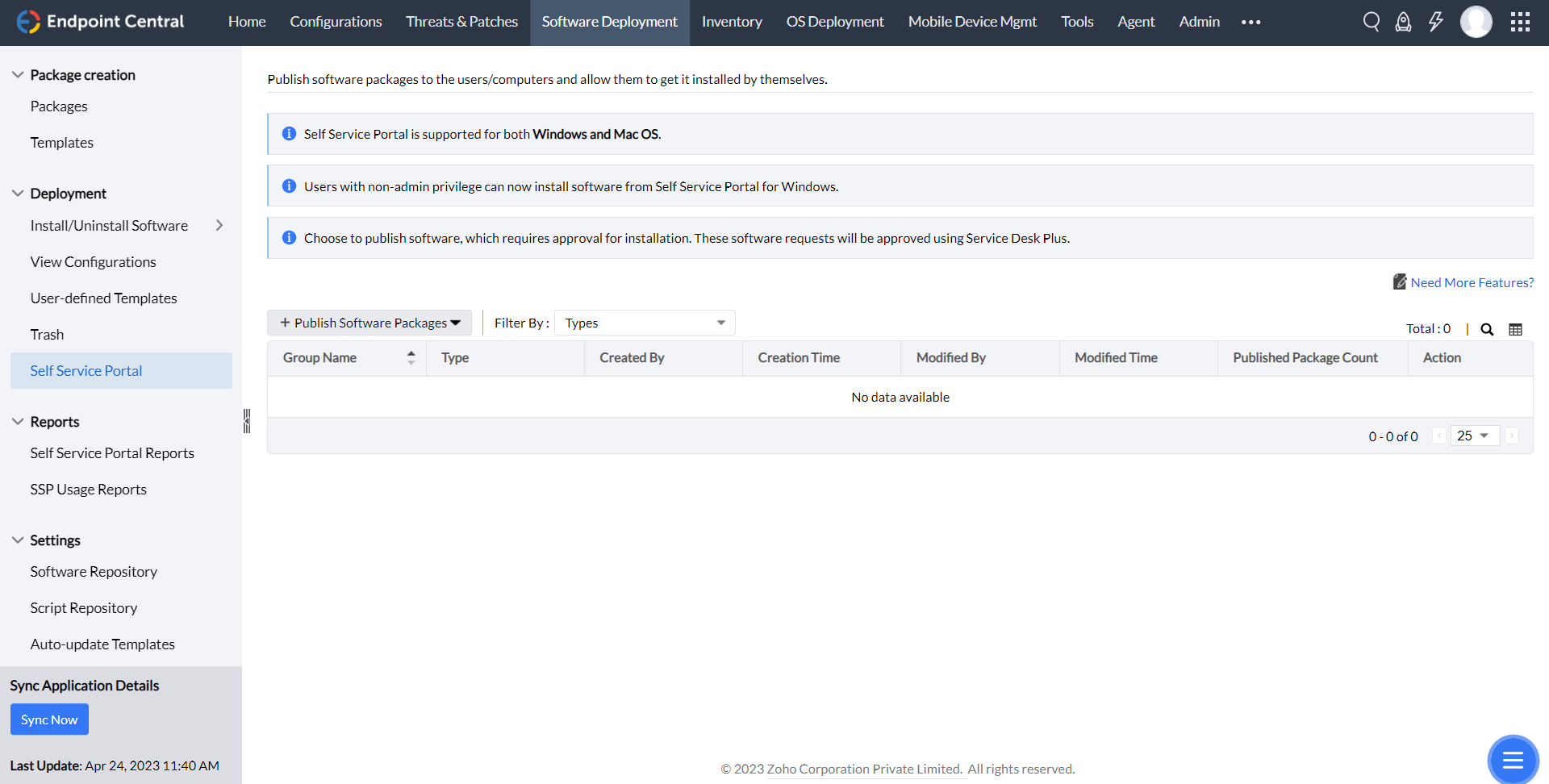
One of the most common task of an IT admin is deploying requested applications to users, for which a lot of help desk tickets are raised regularly. These tickets usually take up lot of time and resources to resolve. Using our self service portal you can publish software and patches, thereby empowering users to install applications and patches on their own. All you need to do is publish most commonly requested applications and tested patches to the self service portal and reduce the number of help desk tickets raised, all thanks to automated deployment.
Enterprise app catalogue
Provide employees with an easy-to-use platform for finding, accessing, and installing software applications. Build a catalogue of apps that employees can easily discover and install thereby, saving time and reducing the need for IT support. Ensuring that only approved applications are used can help the organization remain compliant with industry regulations and data protection requirements. A well-designed app catalog also simplifies the user experience and promotes satisfaction among employees who can quickly access the tools they need.
Pre Deployment activities
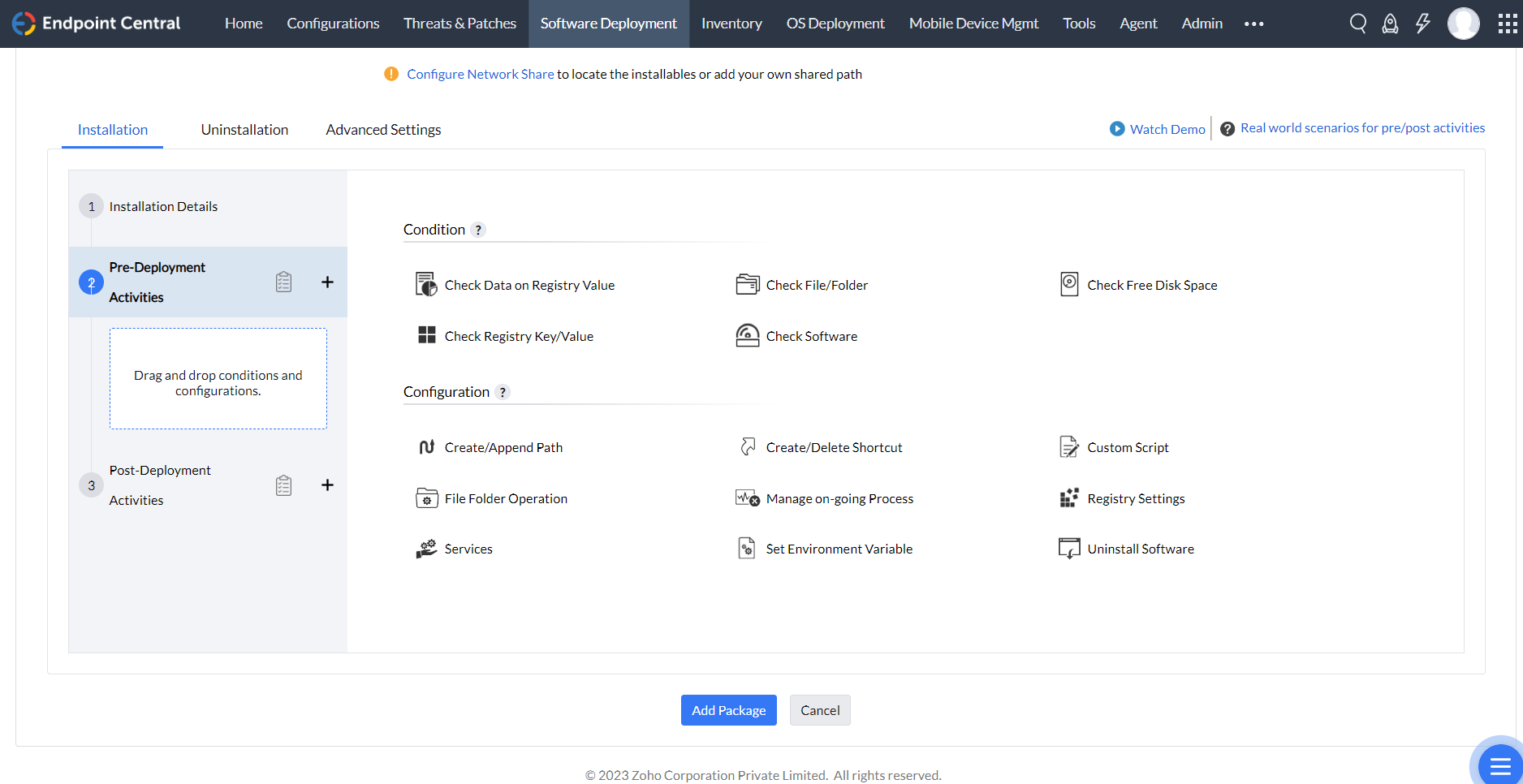
One of the major reasons for software deployment failure is that the target computers don't meet the prerequisites. It can take up a lot of time to figure out the exact issue and then troubleshoot it accordingly. You can perform condition checks and apply configurations before installation with pre deployment activities, accelerating your enterprise software deployment process. It ensures that the target computers meet all the requirements and have all the configurations set up before you apply any deployment automation tools.
Post Deployment activities
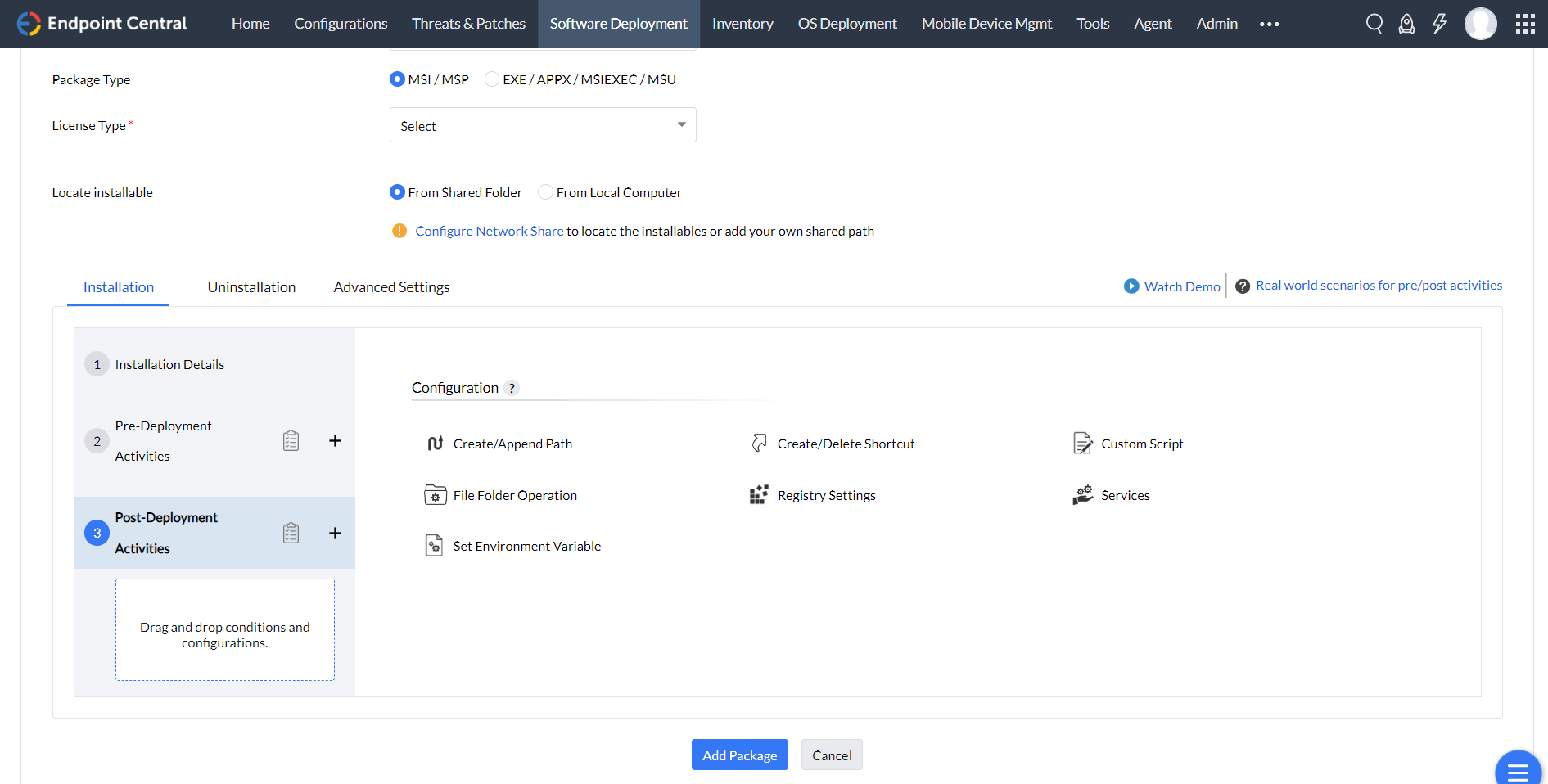
Post deployment activities help you ensure that the application is accessible to user, all the previous versions have been uninstalled, shortcuts have been set up and all the application specific configurations are applied. The post deployment activities empower your automatic software deployment process by allowing you to apply follow-up configurations, run custom scripts, change registry settings, create shortcuts, create/append path, and much more after installation. Learn more about software deployment methods and strategies.
Installation/uninstallation using the same package
Creating different packages for installing or uninstalling the same application can get tedious. Once you create a package, it can be used to perform both the operations for MSI, EXE, MSU, APPX and MSP applications.
Schedule deployment
Downloading the software packages and running the executables takes up a lot of processor's resources, which may lead to reduced performance while deployment and hence loss of productivity for employees. To prevent this, you can deploy software packages within a suitable time interval by configuring a deployment policy for an automated deployment. By leveraging these deployment automation tools, you can automate software installations on the desired day/date/time, within a preset time window. Scheduling software deployment via automated deployment tools at off-hours helps bring desired results in terms of cost as well as performance within your environment.
The application allows you to copy the necessary installables to the client computers before installing or uninstalling applications. This can be configured while setting up the deployment policy. It is optional and when selected will speed up the installation/uninstallation process.
Install applications as a user
Our automated software installation tool supports installing or uninstalling the application as a specific user. By default, all applications are installed as "System User", which the Endpoint Central agent has access to.
What is Software Deployment?
Software Deployment is the process of remotely installing software on multiple or all the computers within a network simultaneously, from a central location. The word "Software Deployment" is generally used in the context of a large network (more than 20 computers). An automated deployment using enterprise software deployment tools helps in distributing software without manual intervention saving time and effort.
Patch management and IT asset managementmodules of Endpoint Central usually work in tandem with software deployment feature, as they are responsible for software updates and have complete control and visibility over the software installed across your network.
Why do you need an automated software deployment solution?
All the above- mentioned activities can be taken care of manually or via automated software deployment tools. Doing it manually might be fine if you have a network of say, 15 computers, but anything beyond that becomes labor intensive, cost ineffective and is prone to redundancy. Even after having multiple technicians working on it manually, one cannot guarantee that all endpoints have the latest versions of software installed and configured. Hence, you need a centralized software deployment automation in place for all your software deployment needs. Automated software deployment also ensures minimal errors and more frequent deployments.
How to automate deployment using Endpoint Central?
The application allows automated deployment with the help of automatic package creation. You can automate software installation by adding over 10000 predefined software deployment templates to create a package and publish it to a specific user. The packages in these templates can be set to auto-update. So, whenever a new version of a template is available, it will be reflected in the Self Service Portal of the published users. To get started with automated deployment of software, navigate to Software Deployment > Settings > Auto-update Templates. Thus, by making use of the automated deployment tools, IT administrators and entire organisations can save resources.
Related Pages

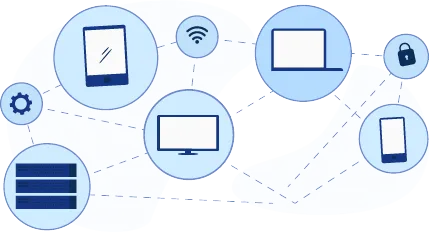
"Manage Engine is solving our patching and software deployment issues. We can easily setup automatic deployments for new and existing software. This allows us to deploy a lean image and then have software delivered afterwards based on user needs. Manage engine also keeps track of our software licenses so that we don't run into compliance issues."
Frank F,
Senior Client support Services Specialist,
Review collected by and hosted on G2.